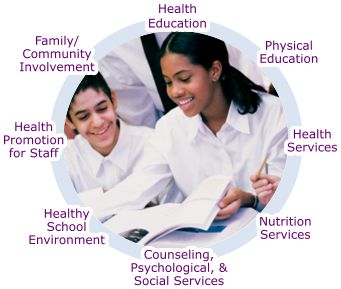

|
Coordinated School Health Program |
|


 |

|

Coordinated School Health Program
What is a CSHP?
A coordinated school health program (CSHP) model consists
of eight interactive components. Schools by themselves cannot—and should
not be expected to—solve the nation’s
most serious health and social problems. Families, health care workers, the media, religious organizations, community
organizations that serve youth, and young people themselves also must be
systematically involved. However, schools could provide a critical facility in
which many agencies might work together to maintain the well-being of young
people.
Eight Component Model
The following are working descriptions* of the eight components of a
coordinated school health program.

- Health Education: A planned,
sequential, K-12 curriculum that addresses the physical, mental, emotional and social
dimensions of health. The curriculum is designed to motivate and assist students to
maintain and improve their health, prevent disease, and reduce health-related risk
behaviors. It allows students to develop and demonstrate increasingly sophisticated
health-related knowledge, attitudes, skills, and practices. The comprehensive
health education curriculum
includes a variety of topics such as personal health, family health, community health,
consumer health, environmental health, sexuality education, mental and emotional health,
injury prevention and safety, nutrition, prevention and control of disease, and substance
use and abuse. Qualified, trained teachers provide health education.
- Physical Education: A planned,
sequential K-12 curriculum that provides cognitive content and learning experiences in a
variety of activity areas such as basic movement skills; physical fitness; rhythms and
dance; games; team, dual, and individual sports; tumbling and gymnastics; and aquatics.
Quality physical education should promote, through a variety of planned physical
activities, each student's optimum physical, mental, emotional, and social development,
and should promote activities and sports that all students enjoy and can pursue throughout
their lives. Qualified, trained teachers teach physical activity.
Back to Model
- Health Services: Services provided for
students to appraise, protect, and promote health. These services are designed to ensure
access or referral to primary health care services or both, foster appropriate use of
primary health care services, prevent and control communicable disease and other health
problems, provide emergency care for illness or injury, promote and provide optimum
sanitary conditions for a safe school facility and school environment, and provide
educational and counseling opportunities for promoting and maintaining individual, family,
and community health. Qualified professionals such as physicians, nurses, dentists, health
educators, and other allied health personnel provide these services.
Back to Model
- Nutrition Services: Access to a
variety of nutritious and appealing meals that accommodate the health and nutrition needs
of all students. School nutrition programs reflect the U.S. Dietary Guidelines for
Americans and other criteria to achieve nutrition integrity. The school nutrition services
offer students a learning laboratory for classroom nutrition and health education, and
serve as a resource for linkages with nutrition-related community services. Qualified
child nutrition professionals provide these services.
Back to Model
- Counseling and Psychological
Services: Services provided to improve students' mental, emotional, and
social health. These services include individual and group assessments, interventions, and
referrals. Organizational assessment and consultation skills of counselors and
psychologists contribute not only to the health of students but also to the health of the
school environment. Professionals such as certified school counselors, psychologists, and
social workers provide these services.
Back to Model
- Healthy School Environment:
The physical and aesthetic surroundings and the psychosocial climate and culture of the
school. Factors that influence the physical environment include the school building and
the area surrounding it, any biological or chemical agents that are detrimental to health,
and physical conditions such as temperature, noise, and lighting. The psychological
environment includes the physical, emotional, and social conditions that affect the
well-being of students and staff.
Back to Model
- Health Promotion for Staff:
Opportunities for school staff to improve their health status through activities such as
health assessments, health education and health-related fitness activities. These
opportunities encourage school staff to pursue a healthy lifestyle that contributes to
their improved health status, improved morale, and a greater personal commitment to the
school's overall coordinated health program. This personal commitment often transfers into
greater commitment to the health of students and creates positive role modeling. Health
promotion activities have improved productivity, decreased absenteeism, and reduced health
insurance costs.
School Wellness Guide:* A Guide
for Protecting the Assets of Our Nation's Schools is a comprehensive guide
that provides information, practical tools and resources for school employee
wellness programs.
Back to Model
- Family/Community Involvement: An integrated school, parent, and community approach for enhancing the health and
well-being of students. School health advisory councils, coalitions, and broadly based
constituencies for school health can build support for school health program efforts.
Schools actively solicit parent involvement and engage community resources and services to
respond more effectively to the health-related needs of students.
Back to Top
|
* |
Links to non-Federal organizations are provided solely as a service to our users. Links do not constitute an endorsement of any organization by CDC or the Federal Government, and none should be inferred. The CDC is not responsible for the content of the individual organization Web pages found at this link.
|
* The above descriptions were adapted from multiple sources including:
Allensworth DD, Kolbe LJ. The comprehensive school
health program: exploring an expanded concept. Journal of School Health 1987;57(10):
409–12.
Institute of Medicine. Schools and Health: Our
Nation’s Investment. Washington, DC: National Academy Press. 1997.
Marx E, Wooley SF, Northrop D.
"Health Is Academic: A Guide To Coordinated School Health Programs."
Teachers College Press, 1998.
|

|
